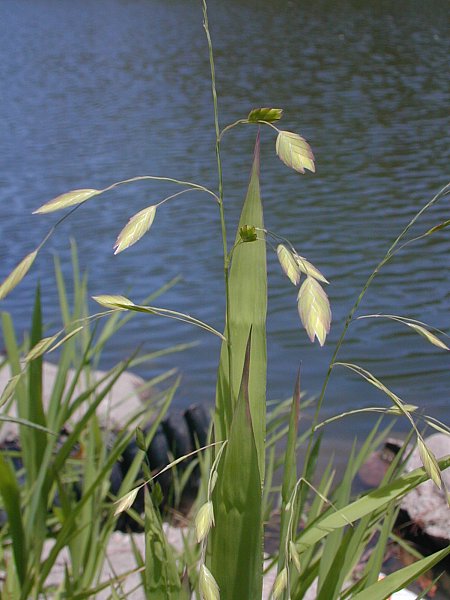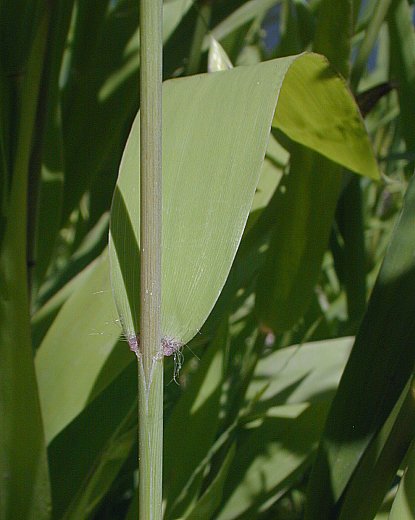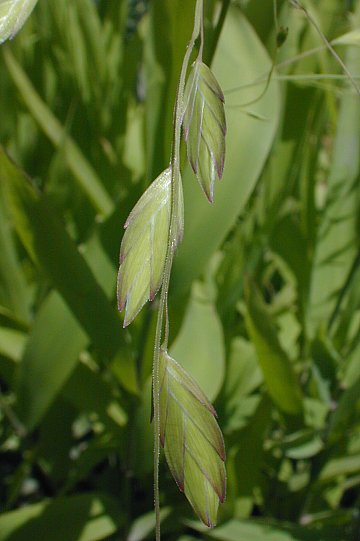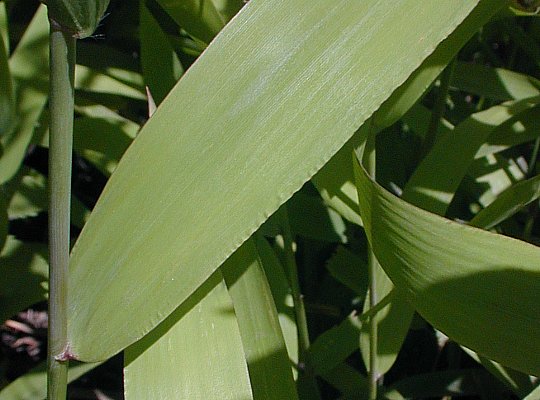Description: This perennial grass is 1½–4' tall and unbranched or little-branched. The slender culm is light green, glabrous, and terete (round in cross-section); several alternate leaves occur along its entire length. The leaf blades are up to 10" long and 1" across; they are linear-lanceolate, light to medium green, flat, and hairless. The leaf sheaths are light green, hairless to minutely pubescent, and open toward their apices. The ligules are conspicuously ciliate. The culm terminates in a panicle of spikelets about 4-12" long and about one-half as much across. The panicle is more or less erect, although its lateral branches and pedicels are drooping. Along the rachis (central stalk) of the panicle, there are 1-2 lateral branches originating from its nodes; each of these lateral branches terminates into 2-6 spikelets with pedicels. The rachis, lateral branches, and pedicels are light green, slender, and glabrous to minutely pubescent.

Individual spikelets are ¾–1½" long, about ½" across, and strongly flattened; they are light green (while immature) and mostly glabrous. Sometimes the spikelets are tinted red along their margins near the tips of their lemmas. Each spikelet consists of a pair of glumes at the bottom and 5-15 lemmas above that are arranged in 2 overlapping ranks. The lowest 1-2 lemmas in a spikelet are often sterile. The glumes are 5-7 mm. long, lanceolate in shape, longitudinally veined, and strongly keeled. The lemmas are 6-12 mm. long, ovate in shape, longitudinally veined, and strongly keeled; the sterile lemmas are smaller in size than the fertile lemmas. The keels of the lemmas are minutely pubescent. Each perfect floret of a fertile lemma has 2 stigmas,a single anther, and an ovary. The blooming period occurs from mid-summer to early autumn, lasting about 1-2 weeks. The florets are cross-pollinated by the wind. Afterwards, the spikelets become tan to reddish bronze; the lemmas disarticulate individually from their spikelets, while the glumes are persistent. Mature grains are 2–2.5 mm. long and flattened-lanceoloid in shape. The root system is fibrous and rhizomatous; clonal colonies of plants often develop from the rhizomes.

Cultivation:
The
preference is partial sun, moist conditions, and a loamy or rocky soil.
Plants tend to be smaller in areas that are drier and less fertile.
Range & Habitat:
The native Inland Oats is common in the southern half of Illinois, but
it is uncommon or
absent in the northern half of the state (see Distribution
Map). This is primarily a southern species as Illinois lies
along the northern edge of its range-limit. Habitats include moist
alluvial meadows, rocky slopes along streams, limestone glades, thinly
wooded areas in river floodplains, moist woodlands, and woodland
borders. Some local populations may derive from plants that have
escaped cultivation.

Faunal
Associations:
The flowers attract few insects because they are wind-pollinated. The
caterpillars of the butterfly Enodia anthedon
(Northern Pearly Eye) feed on the foliage of Inland Oats, as do the
caterpillars of several Amblyscirtes spp. (Roadside
Skippers), including Amblyscirtes vialis (Common
Roadside Skipper), Amblyscirtes linda (Linda's
Roadside Skipper), and Amblyscirtes belli
(Bell's
Roadside Skipper); see Bouseman & Sternburg (2001) and Bouseman
et al. (2006). The latter two skippers are restricted to southern
Illinois and neighboring areas, where their preferred food plant,
Inland Oats, is more common. The larvae of a moth, Elachista brachyelytrifoliella
mine the leaves of Inland Oats and other woodland grasses (Microleps
website).
Photographic Location:
Along the rocky edge of a pond at a city park in Champaign, Illinois.

Comments: This attractive grass is often cultivated in gardens and the branches of its spikelets can be used in flower arrangements and winter bouquets. Inland Oats (Chasmanthium latifolia) is easy to identify because of its large flat spikelets and broad leaves. The nodding spikelets move about on their slender pedicels with each passing breeze. An obsolete scientific name for this plant is Uniola latifolia. It has several common names, including Broad-Leaved Uniola, Wild Oats, River Oats, Indian Wood Oats, and Northern Sea Oats. The common name 'Sea Oats' usually refers to another species, Uniola paniculata, which is not found in Illinois. Sea Oats occurs primarily along coastal areas that are sandy. It is a taller plant with more erect spikelets, and each of its florets has 3 anthers, instead of a single anther.